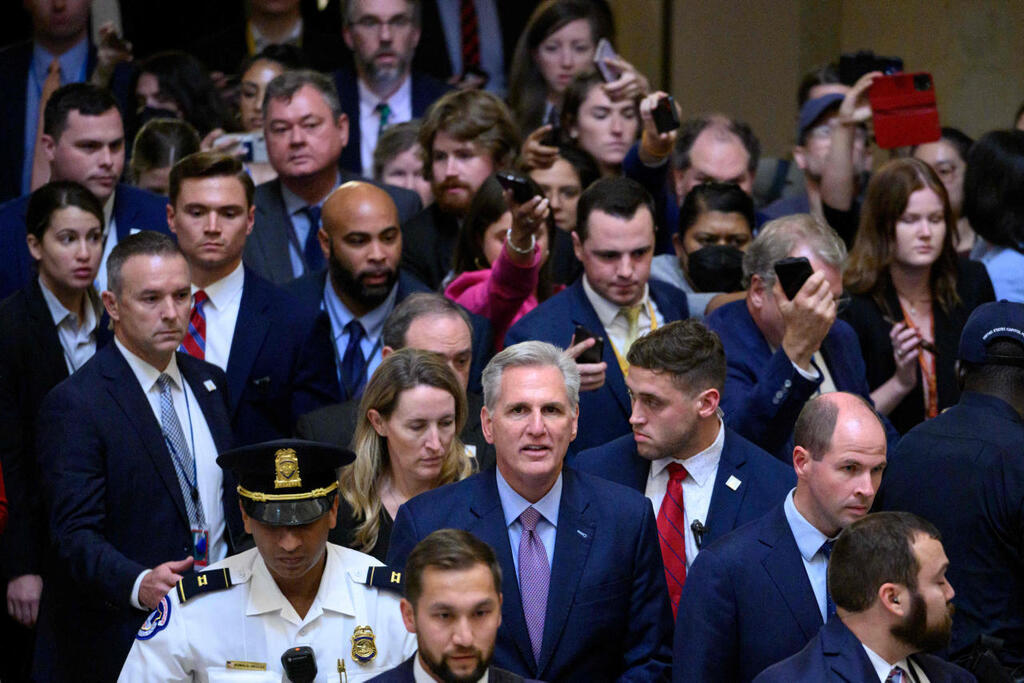
A house divided: Congress shockwaves will hit Israel
Government bond yields in the US - the security that reflects the level of confidence or lack of confidence in the local economy - jumped this week to a 16-year high and to levels seen immediately before the financial crisis in 2008; The jump in yields makes money more expensive and destabilizes the economy, and it seems that the reasons behind this will not disappear soon
American politics have provided numerous dramas in recent years, and this time it's an economic-financial drama. The chaos and uncertainty in the U.S. Congress have pushed the yield on ten-year U.S. government bonds to a 16-year high.
The 10-year American bonds are the most traded security, and the bond yield with a negative correlation is an indication of the state of confidence in the local economy. The bond yield jumped by almost 12 basis points earlier this week and crossed the threshold of 4.8% - a rate similar to that recorded in August 2007, on the eve of the collapse of the American financial system that led to the global financial crisis.
Such an event may have an impact not only on the largest economy in the world but also on economies worldwide, including Israel.
Government bond yield is also known as "long-term interest," compared to the central bank interest (in this case, the US Federal Reserve) known as "short-term interest." The long-term interest rate reflected in the bond is actually the "price of money." Intuitively, if a friend asked us for a 10-year loan, it is likely that in return we would ask them for the yield of a 10-year government bond.
Before detailing the reasons for the jump in bond yields, let's start with their consequences: a sharp increase in the price of money in the long term. That is, the increase in the cost of loans (including mortgages) whose long-term interest rates are derived from the same government bond interest rate - which is the cornerstone of the capital market - the basis of every security.
The increase in the cost of loans means less investment, fewer home purchases, reduced hiring, and, of course, decreased private consumption, including for sustainable products (which are more expensive, such as cars and electrical and media products). This is because financing costs are climbing.
A Goldman Sachs report published last week revealed that the rate of debt written off by credit card companies in the U.S. is the highest since 2008. The worst news in the forecast is that by the end of 2024, this process will reach its peak.
If we continue with this chain of events one more step, we reach the extreme scenario: a slowdown in economic activity that may reach recession levels (negative growth, i.e., a decrease in GDP).
The scenario of a recession in the U.S. economy is the ultimate fear: when the largest economy in the world - which records impressive performance despite inflation and interest rate increases - "gets the flu," the entire global economy "sneezes." In other words, the hard landing scenario is again on the table.
There is a close relationship between the short-term interest rate - the Fed interest rate - and the long-term interest rate - the government bond yields. The natural tendency is for a positive correlation in movements - as the short-term interest rate rises, the long-term interest rate also rises - because the price of money is the price of money.
After the great financial crisis in 2008, the central banks reset the short-term interest rate, and when they reached zero interest rate, they started buying government bonds to increase the bond prices and thus lower their yield (in bond trading, the bond price and the yield on it move in opposite directions). Now, the opposite is happening.
The connection between the Fed interest rate and bond yields is the reason why every reassessment of the direction of inflation - the main parameter that guides the Fed's policy - causes a shift and nervousness in the bond market as well. The American central bank holds a great responsibility these days.
Fed Chairman Jerome Powell and the other bank executives must be careful with the movements in the short-term interest rate because it affects the long-term interest rate, and the balance is very delicate. "Too much" could create a complete mess in the American and global economy: financial instability, a jump in financing costs, and even lead to a financial crisis and a recession. "Too little" may provide a boost to inflation, which is still high and received a renewed impetus from the renewal of energy price increases in the recent period.
But the jump in government bond prices in the U.S. is also explained by real variables; the jump in bond yields actually stems from a massive sell-off of that bond.
Related articles:
Here we return to the political story and the behavior of the U.S. government. After all, it is a bond of an issuing body, and the main parameter that should affect it is the financial soundness of that body - the U.S. government. The level of the deficit, the economic debt, and, of course, the level of activity in that economy, reflected in taxes, determine whether the bond is more or less risky.
The numbers are not encouraging: the U.S. government deficit is expected to reach $2 trillion in 2023 compared to $1 trillion in 2022. This is due to a decrease in tax receipts, a jump in social spending, and a sharp increase in interest rates on the debt (those government bonds). Furthermore, the American public debt already stands at $33 trillion because the deficits started in 2008 (then the debt stood at "only" $13.6 trillion). The overall long-term fiscal picture for the U.S. looks bleak.
The fact that growth in the U.S .is still very strong (also the Fed, together with international economic organizations, updated the U.S. growth forecast upwards), as well as the fact that inflation has not calmed down, along with the estimate that the Fed interest rate will remain higher for longer than initially observed, together with the government's negative fiscal indicators, reinforce the feeling that the variables that push the continued jump in yields are strong enough and determined to stay.
Therefore, one must prepare for the new reality: a yield of 4.8% or more in American bonds, which were considered a safe haven. As a result of the high yields of the bonds, a significant influx of Israeli money is expected, supporting the continued devaluation of the shekel (mainly due to the strengthening of the dollar worldwide).
Devaluation is an inflationary engine in Israel - which, if accelerated, will oblige the Bank of Israel to continue raising short-term interest rates, leading to a strengthening of the "long" interest rate in Israel. The increase in the price of money will put pressure on the Israeli public debt and will require more budget for debt service. Therefore, the next step will be cuts or tax increases.














